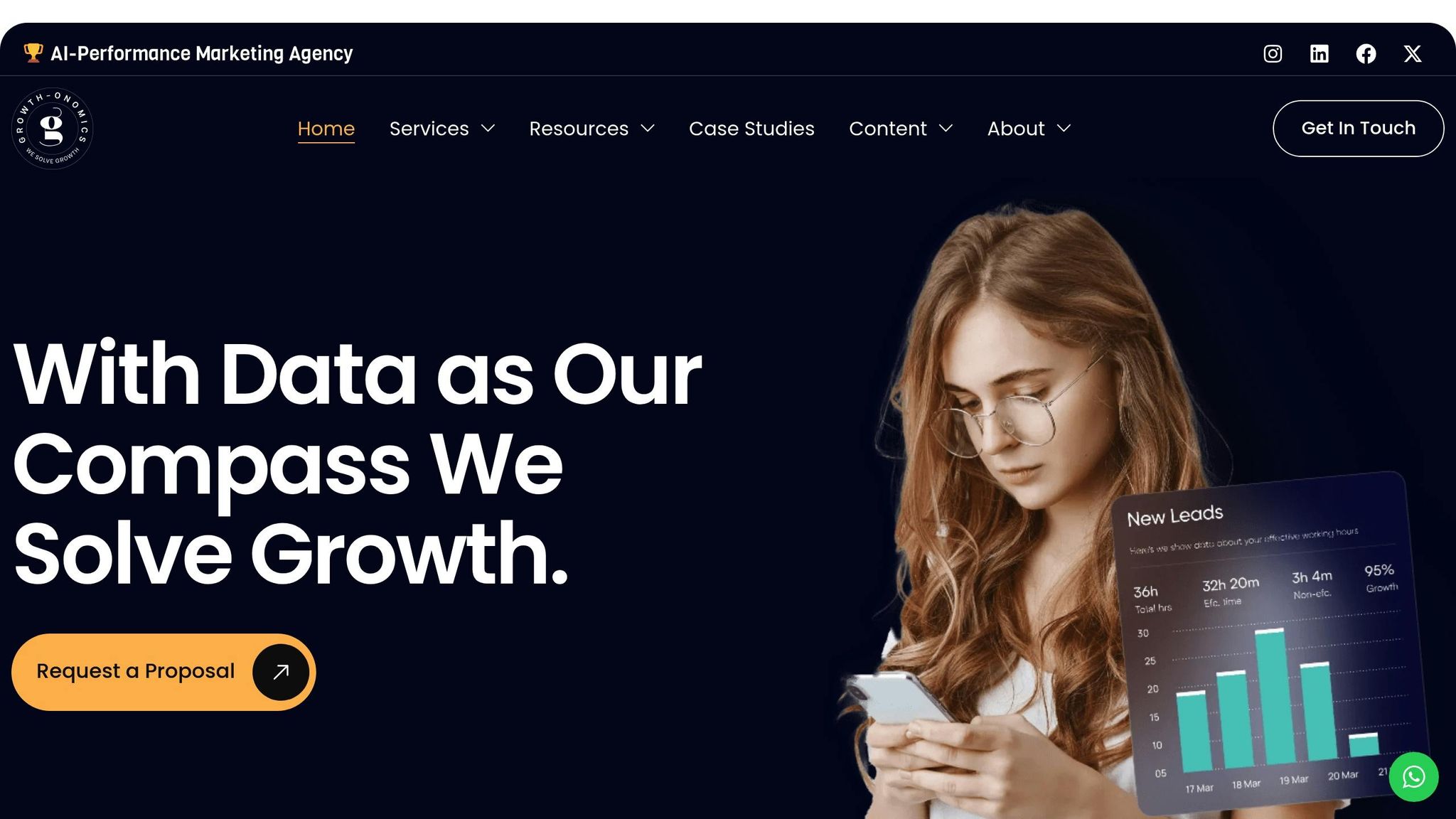Validating a growth hypothesis is about testing ideas to see what works for your business growth. Here’s how:
- What is a Growth Hypothesis?
It’s a clear prediction of how a specific action will impact a measurable metric, like:
"Adding live chat will increase conversion rates from 2% to 3.5% in 30 days." - Why Validate It?
- Save time and money by focusing on what works.
- Reduce risks by testing ideas before scaling.
- Build strategies that can grow sustainably.
- Steps to Validate:
- Write a Clear Hypothesis: Include the action, expected result, metric, and timeframe.
- Test It: Use A/B or multivariate testing to gather data.
- Analyze Results: Compare outcomes to your baseline.
- Decide Next Steps: Scale, tweak, or drop the idea based on the data.
- Avoid Common Mistakes:
- Don’t test multiple changes at once.
- Set realistic expectations (e.g., aim for a 2–5% improvement).
- Make sure your sample size is big enough for reliable results.
Step 1: Writing Clear Growth Hypotheses
Required Components
A solid growth hypothesis needs four key elements:
| Component | Description | Example |
|---|---|---|
| Expected Change | The specific action or modification | Adding live chat support |
| Success Metric | A measurable outcome | Conversion rate |
| Timeframe | The duration of the test | 30 days |
| Baseline Data | Current performance figures | Current 2% conversion rate |
When combined, these elements form what Growth-onomics refers to as a "testable statement." For example: "Implementing live chat support will increase our conversion rate from 2% to 3.5% within 30 days".
Matching Business Goals
Your hypothesis should align with a core business goal. Here are some common objectives and their related metrics:
- Customer Acquisition: Focus on metrics like conversion rates, sign-up completions, or lead generation.
- Customer Retention: Monitor repeat purchase rates, subscription renewals, or engagement metrics.
- Revenue Growth: Track average order value, customer lifetime value, or sales velocity.
By tying your hypotheses to these goals, you set a clear direction for testing and evaluation.
Sample Hypotheses
Here are some examples of well-crafted hypotheses for different industries:
E-commerce Example
"Adding free shipping for orders over $50 will increase the average order value by $8 within 30 days".
SaaS Example
"Implementing a personalized onboarding email sequence will improve the 7-day user retention rate from 65% to 70% over the next 60 days, compared to our current generic welcome email".
Service Business Example
"Adding customer testimonials to our landing page will increase lead form submissions by 15% (from 100 to 115 per week) within the next 45 days".
The key is to ensure your hypotheses are specific, measurable, tied to your business objectives, and capable of being tested. This approach provides a clear path to evaluate whether your strategies are driving the desired results.
Step 2: Setting Up Test Experiments
Selecting Test Methods
Choosing the right testing method is crucial for validating growth hypotheses effectively. A/B testing works well when you need to focus on a single variable – like comparing "Start Free Trial" with "Try Now" buttons to see which drives more conversions. For situations where multiple factors might influence results at the same time, multivariate testing is a better option.
| Test Type | Best Used For |
|---|---|
| A/B Testing | Evaluating changes to a single variable |
| Multivariate Testing | Measuring the impact of multiple changes |
Selecting the right method ensures your experiments are both efficient and insightful.
Building Test Products
When creating test products, aim to balance speed with quality:
- Minimum Viable Test
Start small to validate your hypothesis without overcommitting resources. For instance, instead of building a fully functional live chat system, you could test user interest with a simple chat widget that operates only during business hours. This lets you gather insights quickly and decide whether further investment is worthwhile. - Implementation Guidelines
Focus on testing one variable at a time to ensure your data is clear and actionable. Consistency in tracking is key to avoiding confusion in your results.
Once your test product is ready, the next step is setting up analytics to interpret your findings.
Setting Up Analytics
Analytics configuration is essential for gathering meaningful insights. Your tracking tools should measure key performance indicators (KPIs) and user behaviors that align with your goals.
| Metric Type | Examples |
|---|---|
| Primary KPIs | Conversion rate, Revenue |
| Secondary Metrics | Time on page, Bounce rate |
| User Behavior | Click patterns, Scroll depth |
"With Data as Our Compass We Solve Growth." – Growth-onomics
Here’s what to focus on when setting up analytics:
- Baseline Metrics: Track your current performance for at least two weeks before starting the test. This establishes a reliable benchmark.
- Test Metrics: Measure both immediate and delayed effects of your experiment to capture the full picture.
- Segmented Data: Break results down by user type, device, and traffic source to uncover deeper insights.
Set up event tracking for key user actions, such as monitoring each step in an onboarding process. Be sure to run your tests for the full duration specified in your hypothesis – cutting them short can lead to misleading conclusions and missed opportunities to learn.
Step 3: Making Data-Based Decisions
Using Statistics
When analyzing test results, it’s essential to:
- Ensure your sample size is large enough to provide reliable data.
- Keep the test duration consistent across all variants.
- Minimize external influences, such as seasonality or overlapping marketing campaigns.
These statistical measures should work hand-in-hand with observations of how users actually interact with your product or service.
Reading User Behavior
To understand what your audience is doing, dive into tools and techniques like:
- Heatmap Analysis: See where users click, scroll, or linger the longest.
- Session Recordings: Replay user sessions to identify pain points or barriers.
- Funnel Analysis: Track the user journey to spot where conversions drop off.
By combining these insights, you can make informed decisions about whether to scale up, tweak, or abandon a hypothesis.
Making Keep or Kill Decisions
Deciding whether to move forward with a hypothesis? Consider these three factors:
- Statistical Validity
Ensure your data is reliable and meets confidence thresholds. - Business Impact
Evaluate how the changes affect revenue or growth. Even small conversion boosts can lead to significant returns. - Resource Requirements
Weigh the costs of implementation against the potential benefits.
"With Data as Our Compass We Solve Growth." – Growth-onomics
This structured approach ensures every decision is backed by a clear understanding of its potential impact, guiding the next steps in your growth strategy.
Step 4: Fixing Common Testing Mistakes
Common Testing Errors
Testing growth hypotheses can be tricky, even for seasoned professionals. Here are some common pitfalls to steer clear of:
Overlapping Tests
Running multiple tests at the same time on the same group of users can lead to skewed results. To avoid this, either segment your audience carefully or consider using multivariate testing methods.
Vague Hypothesis Statements
Hypotheses like "improving the website will increase sales" are too broad and lack direction. Instead, focus on creating specific, measurable statements. For example:
"Reducing checkout steps from 5 to 3 will increase completed orders by 15% within one month."
Unrealistic Expectations
Expecting massive gains, like a 50% improvement, can set you up for disappointment. A more realistic target is a 2–5% improvement.
Once you’ve addressed these issues, the next step is ensuring you have enough data to validate your results.
Getting Enough Test Data
To confirm whether your hypothesis holds up, you need a solid amount of data. Here’s how to make sure your sample size is sufficient:
Calculate the Required Sample Size
Statistical tools can help you figure out how much data you need. Key factors to consider include:
- Baseline conversion rate
- Expected effect size
- Desired confidence level (usually 95%)
- Statistical power
Plan the Test Duration
Short testing periods often produce unreliable results. Instead, plan your test duration based on these factors:
| Factor | What to Consider |
|---|---|
| Traffic Volume | Lower traffic means longer test periods |
| Seasonal Effects | Weekly or monthly patterns can impact results |
| Business Cycles | Be mindful of peak vs. off-peak activity |
Measuring Starting Points
Before diving into testing, it’s crucial to establish a clear baseline to measure your progress against.
Key Baseline Metrics
Track at least two weeks of baseline data to understand your starting point. Focus on metrics like:
- Current conversion rates
- User engagement levels
- Key performance indicators (KPIs)
- Revenue figures
Documentation Best Practices
Keep your data organized by recording:
- Date ranges
- Performance data segmented by audience
- Methods used for data collection
This groundwork ensures you’re set up for meaningful and reliable testing results.
sbb-itb-2ec70df
Conclusion: Summary and Action Steps
Process Overview
To validate growth hypotheses effectively, follow a structured and data-focused approach. Here are the key steps:
Define a clear hypothesis
Outline the specific change, the outcome you expect, and the timeframe for measuring results.
Run controlled tests
Establish testing protocols that avoid overlap and ensure sample sizes are large enough to produce reliable data.
Make decisions based on data
Use statistical analysis to interpret results and guide your next steps with confidence.
Growth-onomics Services

Growth-onomics serves as a reliable partner in driving growth, offering services that align with these principles:
| Service Component | Key Benefits |
|---|---|
| Data Analytics & Reporting | Provides accurate baseline measurements and interprets results. |
| A/B Testing Framework | Delivers a structured method for validating hypotheses. |
| Customer Journey Mapping | Pinpoints key opportunities for testing and improvement. |
| Performance Marketing | Executes strategies proven to drive growth. |
Small Business Guidelines
These strategies can be adapted to meet the needs of small businesses by concentrating on measurable outcomes:
Start small and scale smartly
Kick off with hypotheses that require minimal investment but have clear potential for returns. Test one variable at a time to maintain clarity in results.
Leverage existing data
Dive into your current data to monitor essential performance indicators like:
- Conversion rates
- Customer acquisition costs
- User engagement
- Revenue per customer
Growth-onomics’ data analytics services can uncover patterns in your customer behavior, turning those insights into actionable plans for growth.
"With Data as Our Compass We Solve Growth." – Growth-onomics
Andy Rachleff on the value hypothesis and growth hypothesis
FAQs
How do I ensure my growth hypothesis aligns with my business goals?
Aligning Your Growth Hypothesis with Business Goals
To make sure your growth hypothesis supports your business objectives, start by defining those objectives with clarity. Pinpoint the key metrics that indicate success for your business – whether it’s revenue growth, customer retention, or user acquisition. Once you’ve nailed down these goals, develop a hypothesis that connects directly to them and can be tested using measurable data.
For instance, if boosting customer retention is your aim, your hypothesis could look something like this: Personalized email campaigns will increase customer retention rates by 10% within three months. This kind of hypothesis is actionable and directly tied to what matters most for your business.
The next step? Validate your hypothesis with data-driven experiments like A/B testing or cohort analysis. The insights you gain will help you refine your strategies and make smarter, growth-focused decisions.
What are the best practices for deciding between A/B testing and multivariate testing to validate a growth hypothesis?
When choosing between A/B testing and multivariate testing to validate a growth hypothesis, it’s important to think about the complexity and focus of your experiment.
If you’re evaluating a single element – like a headline, call-to-action, or button color – A/B testing is the way to go. This method pits two versions (A and B) against each other to see which one performs better. It’s simple, efficient, and works best for experiments with a narrow focus and straightforward changes.
On the flip side, multivariate testing is designed for more layered experiments involving multiple variables. For instance, if you’re testing how different combinations of headlines, images, and layouts influence user behavior, multivariate testing can pinpoint which mix delivers the best results. Keep in mind, though, that this approach demands a larger sample size to achieve reliable results.
In short, stick with A/B testing for quick, focused experiments, and turn to multivariate testing when you’re juggling several variables and need deeper insights.
How can I determine the right sample size and test duration for reliable growth experiment results?
To figure out the right sample size and test duration for your growth experiments, focus on two main elements: the expected effect size (the impact you think your changes will make) and the baseline metrics (like conversion rates or traffic levels). These are essential for calculating how many participants you’ll need to get reliable results.
Statistical tools or calculators can help you estimate the sample size. You’ll need to input factors like your desired confidence level (usually 95%) and statistical power (commonly 80%). As for test duration, make sure your experiment runs long enough to account for natural variations in user behavior – things like weekday versus weekend trends. A good rule of thumb? Run the test for at least one full business cycle (e.g., a week) to capture these fluctuations.
By planning your sample size and test duration carefully, you’ll improve the reliability of your results and minimize the risk of making wrong decisions based on your data.









